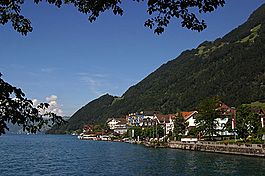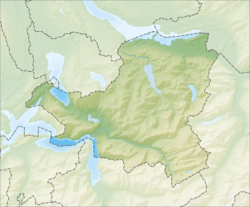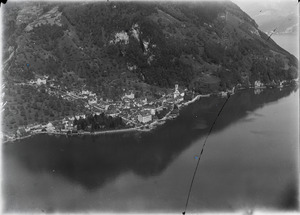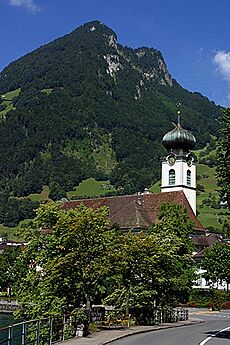Gersau facts for kids
Quick facts for kids
Gersau
|
||
|---|---|---|
 |
||
|
||
| Country | Switzerland | |
| Canton | Schwyz | |
| District | Gersau | |
| Area | ||
| • Total | 14.35 km2 (5.54 sq mi) | |
| Elevation | 435 m (1,427 ft) | |
| Population
(Dec 2020 )
|
||
| • Total | 2,364 | |
| • Density | 164.74/km2 (426.67/sq mi) | |
| Postal code |
6442
|
|
| Surrounded by | Arth, Beckenried (NW), Buochs (NW), Emmetten (NW), Ennetbürgen (NW), Ingenbohl, Lauerz, Vitznau (LU) | |
|
Free State and Republic of Gersau
Freistaat und Republik Gersau
|
|||||||||||||
|---|---|---|---|---|---|---|---|---|---|---|---|---|---|
| 1433–1798 1814–1818 |
|||||||||||||
| Status | City-republic and an allied protectorate of the Old Swiss Confederacy |
||||||||||||
| Capital | Gersau | ||||||||||||
| Government | Republic | ||||||||||||
| Historical era | Early Modern Age | ||||||||||||
|
• Purchased liberty from the Counts of Habsburg
|
1390 | ||||||||||||
|
• Gained Reichsfreiheit
|
1433 | ||||||||||||
|
• Annexed to Helv. Rep.
|
1798 | ||||||||||||
|
• Act of Mediation:
Joined Schwyz |
February 19, 1803 | ||||||||||||
|
• Regained independence
|
1814 | ||||||||||||
|
• Annexed by Switzerland
|
1818 | ||||||||||||
|
|||||||||||||
Gersau is a small town and a district in Switzerland. It's located in the canton of Schwyz, right on the beautiful shores of Lake Lucerne. For many centuries, Gersau was a tiny independent state. It was always a close friend and ally of the larger Swiss Confederation.
Contents
History of Gersau
Gersau was first mentioned in old writings in the year 1064. Over time, the land of Gersau came under the control of the Habsburg family. But in 1333, the rights to Gersau were given to a noble family from Lucerne.
In 1359, Gersau decided to team up with the Old Swiss Confederacy. This was a group of independent states that worked together. Gersau became their "protectorate," meaning the Confederacy would protect it and help it get weapons. The people of Gersau even fought alongside the Swiss for the first time in 1386, at the battle of Sempach.
The Republic of Gersau
The Republic of Gersau was a small, independent state. People called it the "old-free Republic of Gersau." It started in 1390 when the villagers of Gersau bought their freedom from the rulers in Lucerne. This meant they could make their own rules.
In 1433, the Holy Roman Emperor, Sigismund, officially recognized Gersau as a "free imperial state." This meant Gersau was directly under the Emperor's protection and could manage its own affairs. For over 350 years, Gersau was truly independent. It was a special place within the Swiss Confederation, protected by the powerful cantons of Lucerne, Schwyz, Uri, and Unterwalden.
However, this independence didn't last forever. In 1798, the French army invaded Switzerland. Gersau lost its freedom and became part of a new canton called Waldstätten. Later, in 1803, Napoleon Bonaparte changed things again, and Gersau joined the canton of Schwyz.
After Napoleon's rule ended, the people of Gersau declared their independence once more in 1814. The old Swiss cantons even agreed to this. But in 1817, a big meeting of Swiss leaders decided that Gersau should become part of the canton of Schwyz for good. This happened on January 1, 1818. Today, the area of the former republic is the Gersau district within Schwyz.
Gersau bought its freedom from the Habsburgs in 1390 for a lot of money. This allowed the town to become a free community, not controlled by any other power. In 1433, Emperor Sigismund confirmed Gersau's ancient freedoms and rights. This made Gersau a special place with its own courts, covering an area of about 24 square kilometers.
During the French Revolutionary Wars, Gersau was taken over by the Helvetic Republic. It became a district in the canton of Waldstätten. After this republic fell, Gersau was part of the canton of Schwyz until 1814. That year, it became independent again, with Schwyz's approval. The old town hall from 1745, which had council rooms and a courtroom, became a museum.
But in 1817, the Swiss leaders decided that Gersau should join the canton of Schwyz permanently. This happened in 1818, even though Gersau didn't want to. It became the sixth and last district of the canton of Schwyz.
Geography of Gersau
Gersau is in a unique spot, tucked away in a sunny area on the south side of the Rigi mountain. The Rigi-Hochfluh and Gersauerstock peaks protect Gersau from cold winds. The nearby Lake Lucerne also helps keep the weather mild.
Because of this warm climate, Sweet Chestnut trees grow very well here. This is why Gersau is known as the "Riviera of Lake Lucerne" in the region.
Gersau covers an area of about 14.4 square kilometers. About 40% of this land is used for farming. Over half (52.4%) is covered by forests. The rest is made up of buildings, roads, rivers, or mountains.
Until the mid-1800s, you could only reach Gersau by boat on the lake or by crossing a mountain pass from Lauerz. Since 1817, it has been the only town in the District of Gersau.
There's a car ferry that connects Gersau with Beckenried, which is on the other side of Lake Lucerne.
People of Gersau
| year | population |
|---|---|
| 1774 | about 1,000 |
| 1850 | 1,585 |
| 1870 | 2,270 |
| 1880 | 1,775 |
| 1900 | 1,887 |
| 1910 | 2,263 |
| 1950 | 1,890 |
| 1960 | 1,754 |
| 1970 | 1,753 |
| 1980 | 1,813 |
| 1985 | 1,801 |
| 1990 | 1,851 |
| 2000 | 1,965 |
| 2005 | 1,972 |
| 2007 | 1,970 |
Gersau has a population of about 2,300 people. In 2007, about 17.7% of the people living in Gersau were from other countries. Over the last 10 years, the population has stayed about the same.
Most people in Gersau (about 90%) speak German. Other languages spoken include Serbo-Croatian and Italian.
In 2000, about half the population was male (50.5%) and half was female (49.5%). About a quarter of the people (24%) were under 19 years old. Another quarter (24.9%) were between 20 and 39. The largest group, about 34%, was between 40 and 64.
Most people in Gersau are well educated. About two-thirds of adults (ages 25-64) have finished high school or gone on to higher education like university.
In 2000, most people (77.2%) in Gersau were Roman Catholic. About 6.8% belonged to the Swiss Reformed Church. A small number of people belonged to other Christian churches or were Islamic. About 4.65% said they didn't belong to any church.
Important Heritage Sites
The Parish Church of St. Marzellus is a very important building in Switzerland. It's listed as a national heritage site, meaning it's a special place that needs to be protected. The entire village of Gersau is also part of the Inventory of Swiss Heritage Sites, which means it has historical and cultural importance.
Economy and Jobs
In the past, Gersau was known for making silk and working with wood. But today, the main way people make a living is through tourism. Gersau has been a popular place for health and vacation since 1860. There are many hotels and guest houses for visitors.
The unemployment rate in Gersau is quite low, around 1.62%. In 2005, about 105 people worked in farming (the primary sector). About 129 people worked in manufacturing and construction (the secondary sector). The largest group, 350 people, worked in services like tourism, shops, and offices (the tertiary sector).
Local Food
Gersau has some special foods you might enjoy. These include a salty cheesecake and a dessert called Rahmschinken.
Famous People from Gersau
- Walter Nigg (1903–1988), a well-known theologian (someone who studies religion).
- Josef Maria Camenzind (1904–1984), a Catholic priest and writer.
- Benno Ammann (1904–1986), a conductor and composer of music.
- Oskar Camenzind (1971– ), a former professional road racing cyclist who became a world champion in 1998.
See also
 In Spanish: Gersau para niños
In Spanish: Gersau para niños






